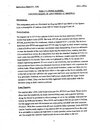Hi Peter,Martyn is correct in saying that torque figures are not given in the First Edition of KTB, but they are given in the Second Edition, on page 161 as 30 lb.ft. and 40 lb.ft. respectively, and it states that those figures are taken from the Works Instruction Sheets.
I have 2 editions of the works sheets One is dated May 1953 - part of it is in the attached jpg. The other is a 'update' by Griffin dated August 1998 - and part of that is the pdf attachment.
BOTH specify that the nuts are to be tightened to 30 ft/lb.
Remember as the motor warms up that the muff will expand upwards at TWICE the expansion/growth rate of the steel studs and that will increase the effective loading on the nuts and studs. Having studs pull out of the cases is a very expensive repair job.
But then again its not my motor.
Martyn

